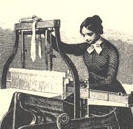|
March 1845 -
Investigation of Labor Conditions
Massachusetts House Document, no. 50, March, l845. Reprinted in John Commons, ed., A Documentary History of American Industrial Society (1910). The first petitioner who testified was Eliza R. Hemmingway (the future second wife of Jesse C. Ferrin). She had worked 2 years and 9 months in the Lowell Factories; 2 years in the Middlesex, and 9 months in the Hamilton Corporations. Her employment is weaving-works by the piece. The Hamilton Mill manufactures cotton fabrics. The Middlesex, woolen fabrics. She is now at work in the Middlesex Mills, and attends one loom. Her wages average from $16 to $23 a month exclusive of board. She complained of the hours for labor being too many, and the time for meals too limited. In the summer season, the work is commenced at 5 o'clock, a.m., and continued till 7 o'clock, p.m., with half an hour for breakfast and three quarters of an hour for dinner. During eight months of the year, but half an hour is allowed for dinner. The air in the room she considered not to be wholesome. There were 293 small lamps and 61 large lamps lighted in the room in which she worked, when evening work is required. These lamps are also lighted sometimes in the morning. About 130 females, 11 men, and 12 children (between the ages of 11 and 14) work in the room with her. She thought the children enjoyed about as good health as children generally do. The children work but 9 months out of 12. The other 3 months they must attend school. Thinks that there is no day when there are less than six of the females out of the mill from sickness. Has known as many as thirty. She, herself, is out quite often, on account of sickness. There was more sickness in the Summer than in the Winter months; though in the Summer, lamps are not lighted. She thought there was a general desire among the females to work but ten hours, regardless of pay. Most of the girls are from the country, who work in the Lowell Mills. The average time which they remain there is about three years. She knew one girl who had worked there 14 years. Her health was poor when she left. Miss Hemmingway said her health was better where she now worked, than it was when she worked on the Hamilton Corporation. She knew of one girl who last winter went into the mill at half past 4 o'clock, a.m., and worked till half past 7 o'clock, p.m. She did so to make more money. She earned from $25 to $30 per month. There is always a large number of girls at the gate wishing to get in before the bell rings. On the Middlesex Corporation one fourth part of the females go into the mill before they are obliged to. They do this to make more wages. A large number come to Lowell to make money to aid their parents who are poor. She knew of many cases where married women came to Lowell and worked in the mills to assist their husbands to pay for their farms. The moral character of the operatives is good. There was only one American female in the room with her who could not write her name.

|